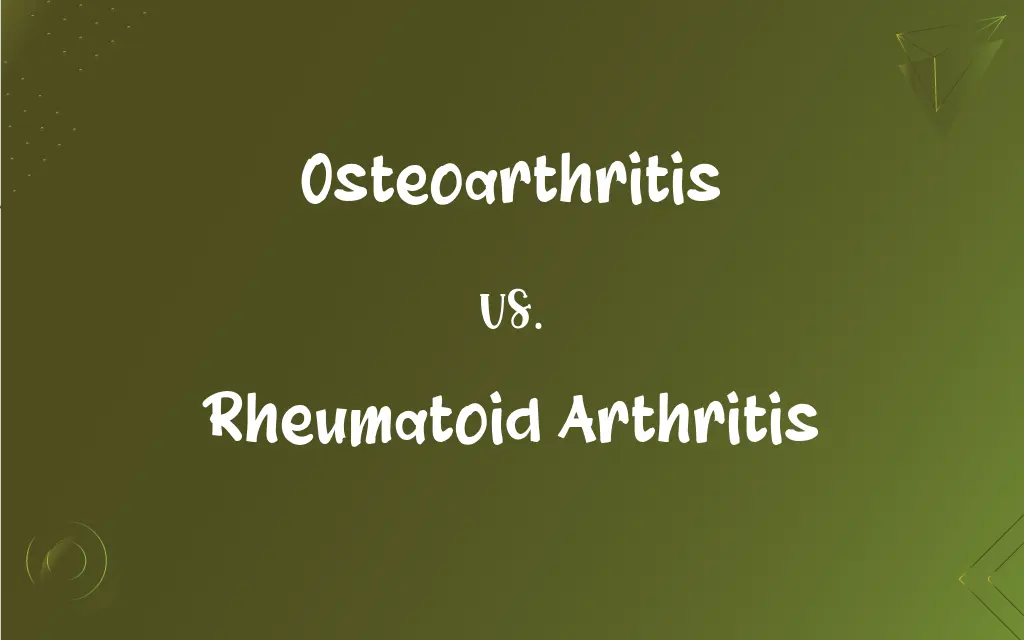Osteoarthritis vs. Rheumatoid Arthritis: What's the Difference?
Edited by Aimie Carlson || By Harlon Moss || Updated on October 28, 2023
Osteoarthritis is a degenerative joint disease, while rheumatoid arthritis is an autoimmune disorder affecting joints.

Key Differences
Osteoarthritis and rheumatoid arthritis are two common forms of arthritis, but they have different causes and characteristics. Osteoarthritis, often termed "wear-and-tear" arthritis, is a condition where the cartilage that cushions the ends of bones in joints gradually deteriorates. Rheumatoid arthritis, on the other hand, is an autoimmune disease, which means the body's immune system mistakenly attacks its own joint tissues.
In osteoarthritis, the affected joints can experience pain and stiffness primarily due to the breakdown of cartilage. The joints most commonly affected are those of the hands, knees, hips, and spine. Contrarily, in rheumatoid arthritis, the synovial lining of the joints becomes inflamed, leading to joint damage and pain. Rheumatoid arthritis often affects joints on both sides of the body, such as both wrists or knees.
A significant distinction between osteoarthritis and rheumatoid arthritis is their progression. While osteoarthritis typically worsens over time with joint use, rheumatoid arthritis can progress quickly, causing swelling and deformity in the affected joints. Moreover, patients with rheumatoid arthritis might also experience systemic symptoms, such as fatigue and fever, which are less common in osteoarthritis.
Regarding treatment, osteoarthritis treatments often focus on pain management and improving joint function. Common approaches include weight management, physical therapy, and over-the-counter pain relievers. For rheumatoid arthritis, treatment aims to control the inflammation and prevent joint damage. This often involves disease-modifying antirheumatic drugs (DMARDs) and other anti-inflammatory agents.
The risk factors for osteoarthritis include aging, joint injuries, and obesity, among others. In contrast, rheumatoid arthritis risk factors include gender (more common in women), age, and genetics. It's crucial to understand these differences for accurate diagnosis and effective treatment.
ADVERTISEMENT
Comparison Chart
Primary Cause
Cartilage deterioration
Autoimmune response
Symptoms
Joint pain, stiffness
Joint pain, swelling, systemic symptoms
Progression
Gradual with joint use
Can be rapid with inflammation
Treatment Focus
Pain management, joint function improvement
Inflammation control, prevent joint damage
Common Risk Factors
Age, joint injuries, obesity
Gender, age, genetics
ADVERTISEMENT
Osteoarthritis and Rheumatoid Arthritis Definitions
Osteoarthritis
Osteoarthritis is a joint disease characterized by cartilage breakdown.
Aging often increases the risk of developing osteoarthritis in weight-bearing joints.
Rheumatoid Arthritis
Rheumatoid arthritis can affect multiple joints symmetrically.
Both her ankles were affected by rheumatoid arthritis, limiting her mobility.
Osteoarthritis
Osteoarthritis is often referred to as "wear-and-tear" arthritis.
Years of playing tennis contributed to his osteoarthritis in the knees.
Rheumatoid Arthritis
Rheumatoid arthritis is an autoimmune disorder targeting the joints.
She was diagnosed with rheumatoid arthritis after both her wrists swelled and became painful.
Osteoarthritis
Osteoarthritis results in joint pain and decreased mobility.
Climbing stairs became a challenge due to her severe osteoarthritis.
Rheumatoid Arthritis
Rheumatoid arthritis might cause systemic symptoms like fever.
Beyond joint pain, her rheumatoid arthritis sometimes results in fatigue and low-grade fevers.
Osteoarthritis
Osteoarthritis primarily affects joints like the knees, hips, and spine.
She was diagnosed with osteoarthritis in her hip after persistent pain.
Rheumatoid Arthritis
Rheumatoid arthritis often requires disease-modifying drugs for treatment.
After being diagnosed with rheumatoid arthritis, she started on DMARDs to control the disease's progression.
Osteoarthritis
Osteoarthritis can develop due to age, injury, or obesity.
A previous knee injury in his twenties led to osteoarthritis in his later years.
Rheumatoid Arthritis
Rheumatoid arthritis leads to inflammation of the joint lining.
The inflammation from rheumatoid arthritis caused her fingers to deform over time.
Osteoarthritis
A chronic disease characterized by progressive degeneration of the cartilage of the joints, occurring mainly in older persons. Also called degenerative joint disease.
Osteoarthritis
(pathology) A form of arthritis, affecting mainly older people, caused by chronic degeneration of the cartilage and synovial membrane of the joints, leading to pain and stiffness.
Osteoarthritis
Chronic breakdown of cartilage in the joints; the most common form of arthritis occurring usually after middle age
FAQs
What's the main difference between osteoarthritis and rheumatoid arthritis?
Osteoarthritis is a degenerative disease, while rheumatoid arthritis is an autoimmune disorder.
Is osteoarthritis more common in weight-bearing joints?
Yes, osteoarthritis frequently affects joints like the knees and hips.
Are there surgical options to treat osteoarthritis?
Yes, in severe cases, joint replacement surgeries might be considered for osteoarthritis.
Is it common to use over-the-counter pain relievers for osteoarthritis?
Yes, many individuals with osteoarthritis use OTC pain relievers to manage symptoms.
Which type of arthritis might result from an old joint injury?
Osteoarthritis can develop from previous joint injuries.
Is rheumatoid arthritis more common in women?
Yes, women are more frequently diagnosed with rheumatoid arthritis than men.
How does age affect the risk of osteoarthritis?
Older age increases the risk of developing osteoarthritis.
Can rheumatoid arthritis lead to complications in organs other than joints?
Yes, in rare cases, rheumatoid arthritis can affect the lungs, heart, and other organs.
Which type of arthritis is termed "wear-and-tear" arthritis?
Osteoarthritis is often termed "wear-and-tear" arthritis.
Can rheumatoid arthritis affect other systems in the body?
Yes, rheumatoid arthritis can have systemic effects like fever and fatigue.
Which arthritis type might cause deformities in the fingers?
Rheumatoid arthritis can lead to deformities in the fingers.
Can physical therapy help with osteoarthritis symptoms?
Yes, physical therapy can improve mobility and alleviate pain from osteoarthritis.
Can diet and weight management help alleviate osteoarthritis symptoms?
Yes, weight management can reduce the strain on joints and alleviate osteoarthritis symptoms.
Are there specific blood tests to diagnose rheumatoid arthritis?
Yes, certain blood tests can help diagnose rheumatoid arthritis by identifying inflammatory markers.
Can osteoarthritis be prevented?
While it's hard to prevent entirely, risk factors like obesity and joint injuries can be managed to reduce risk.
Is morning stiffness a common symptom of rheumatoid arthritis?
Yes, individuals with rheumatoid arthritis often experience morning stiffness.
How does rheumatoid arthritis typically progress?
Rheumatoid arthritis can progress quickly, leading to joint damage and deformity.
What's a primary treatment strategy for rheumatoid arthritis?
Treatment often involves disease-modifying antirheumatic drugs (DMARDs).
Are both forms of arthritis hereditary?
Genetics play a role in rheumatoid arthritis risk, while osteoarthritis has a less clear genetic link.
What is the role of the immune system in rheumatoid arthritis?
In rheumatoid arthritis, the immune system mistakenly attacks the joints, causing inflammation.
About Author
Written by
Harlon MossHarlon is a seasoned quality moderator and accomplished content writer for Difference Wiki. An alumnus of the prestigious University of California, he earned his degree in Computer Science. Leveraging his academic background, Harlon brings a meticulous and informed perspective to his work, ensuring content accuracy and excellence.
Edited by
Aimie CarlsonAimie Carlson, holding a master's degree in English literature, is a fervent English language enthusiast. She lends her writing talents to Difference Wiki, a prominent website that specializes in comparisons, offering readers insightful analyses that both captivate and inform.
































































